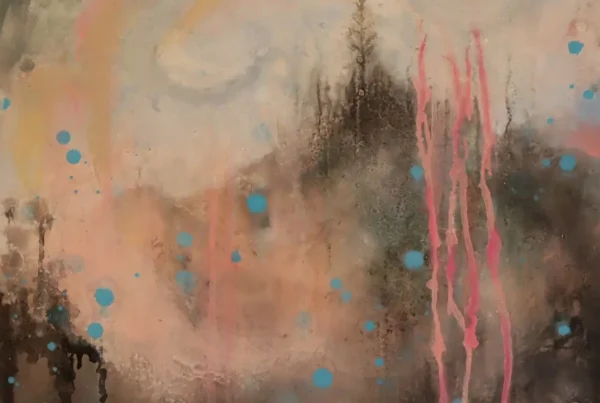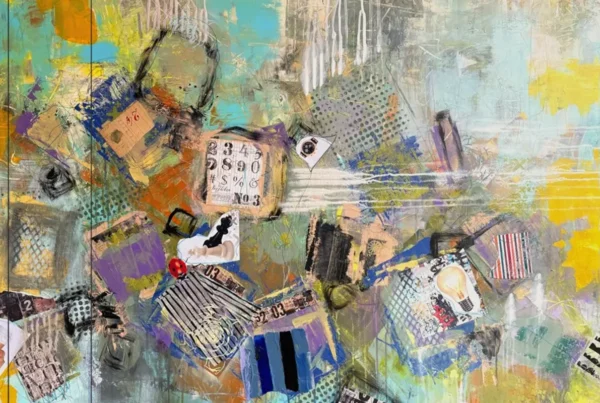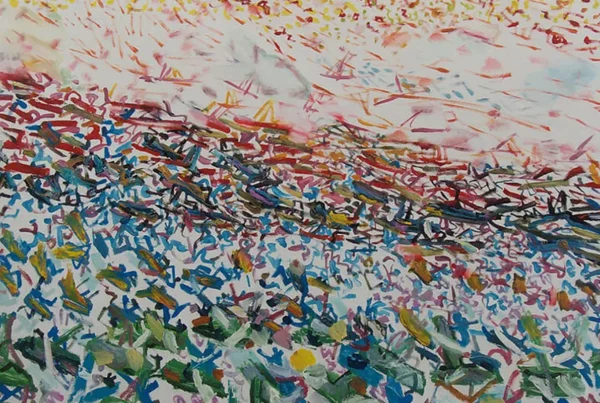“Art is the way that I work to understand and translate this multilayered nature of human experience.”
Exploring Heritage Through Art
Brenna Tomas is a multifaceted artist, writer, mother, and recreation therapist hailing from Sault Ste. Marie, Ontario, part of the Robinson Huron Treaty Territory. Her deeply rooted family history, with connections to both local and international narratives, has played an influential role in shaping her artistic voice. Her maternal and paternal grandparents’ stories of resilience—particularly her Italian nonna’s journey during World War II—provide a backdrop to much of her work, imbuing it with a sense of survival, identity, and adaptation. This diverse heritage, marked by migration, discrimination, and perseverance, is something she continuously explores in her art, blending personal memory with broader historical contexts.
Growing up in a household that emphasized traditional gender roles, Tomas wrestled with the limitations imposed upon women, particularly in the Roman Catholic Church. Her frustration with patriarchal structures was ignited early on, as she questioned why men received positions of spiritual authority while women were confined to lesser roles. This tension between societal expectations and personal belief became a recurring theme in her work. It has led her to create art that challenges conventional norms, focusing on the marginalization of women in both religious and societal contexts.
Her early life, surrounded by stories of struggle, hard work, and survival, laid the groundwork for the art she would later create. Whether reflecting on her ancestors’ experiences or dissecting the gender dynamics that shaped her upbringing, Tomas’ work is deeply introspective. It speaks to the complex, multilayered nature of identity, survival, and self-expression.

Brenna Tomas: Finding Strength Through Art
Art became a transformative force for Brenna Tomas during her mid-twenties, when a series of difficult relationships, including a toxic one, left her searching for independence and a sense of self. It was after the dissolution of these relationships, and especially after becoming pregnant, that Tomas embraced the creative process as a means of survival. Her discovery of her brother’s abandoned graphic design materials marked the beginning of a journey into artistic expression that paralleled her experience of motherhood. This turning point coincided with a profound period of self-discovery, as she moved into her childhood home and began raising her daughter as a single mother.
During this time, Tomas found herself caught between the demands of daily survival and the drive to pursue her passion for art. Unable to rely on financial support and turning to Ontario Works for assistance, she realized that education would be a key to a more stable future. Enrolling in a Bachelor of Psychology and minor in Visual Arts program at Algoma University, Tomas not only furthered her studies but also deepened her commitment to art as both a personal and professional pursuit. This educational path helped her transform the nurturing and creative strengths passed down through generations of women in her family into legitimate artistic skills.
Tragedy struck when Tomas’ mother was diagnosed with terminal cancer, and later, when her daughter’s father was arrested for serious crimes. These emotional upheavals plunged Tomas deeper into her art, as it became her main outlet for processing fear and grief. Despite the challenges, her artistic achievements began to garner recognition. In 2018, she moved to Montreal to attend Concordia University, where she pursued dual degrees in Art History and Studio Arts. The intensity of her experiences—marked by both loss and newfound strength—infused her art with a raw authenticity that resonated with audiences and earned her academic and artistic accolades.

Challenging Perception Through Technique
Tomas’ artistic style can be described as a powerful fusion of surrealism and abstract expressionism. Drawing from influences as diverse as the Renaissance works of Alberti and the psychoanalytic theories of Lacan and Freud, she uses her art to challenge perceptions of reality and representation. Her process is meticulous yet intuitive, often starting with gestural marks that evolve into deeply layered, emotionally charged compositions. She uses traditional techniques and limits her material choices, forcing herself to innovate within strict constraints, which often leads to unique and compelling works.
A prime example of Tomas’ approach is her piece Modern School of Thought. This work, which combines Renaissance-style painting techniques with modern collaged imagery, highlights the contrast between humanistic ideals of the past and the materialistic values of contemporary society. The piece draws inspiration from Raphael’s fresco The School of Athens, replacing historical figures with modern commodities and corporate symbols. By doing so, Tomas critiques modern Western society’s tendency to equate human potential with consumption and wealth, rather than moral or intellectual achievements. The work pushes viewers to reconsider the values that underpin contemporary culture, using visual contrasts to provoke reflection.
This blend of traditional and modern methods is a hallmark of Tomas’ work. She regularly engages in a dialogue between past and present, using classical art as a lens to critique current social, political, and economic systems. Her pieces are both deeply personal and universally relatable, offering a complex commentary on human experience while remaining grounded in her own life’s narrative.

Brenna Tomas: Balancing Art, Family, and Resistance
Brenna Tomas’ life as an artist is interwoven with her role as a mother and partner, where the lines between personal and professional blur. Unlike many artists who require solitude to create, Tomas thrives in the midst of her lively household, finding inspiration and grounding in the sounds of her children playing around her. This chaotic yet nurturing environment mirrors the intensity of her creative process, where distractions become part of the fabric of her work. The demands of her family life are not seen as interruptions but as essential elements of her artistic expression.
In 2021, Tomas faced a new set of challenges when she began a Masters in Education at the University of Ottawa while balancing the care of her partner’s children, who had been placed in their custody. These additional responsibilities did not slow down her artistic production but rather reinforced her belief that art and life are inseparable. The same resilience and determination she applies to building her family are reflected in her commitment to her art. She has learned to channel her emotional struggles into her creations, allowing her frustrations and tensions to fuel her work rather than stifle it.
Through it all, Tomas has remained on the periphery of the mainstream art world, choosing to operate as an outsider. This distance from the traditional art market allows her to stay true to her vision and message, unencumbered by the pressures of commercial success. For Tomas, the act of creating is an essential form of resistance against societal expectations and personal hardship. It is through art that she continually rebuilds herself, finding strength in her creative process and the ever-evolving dynamics of her personal life.






